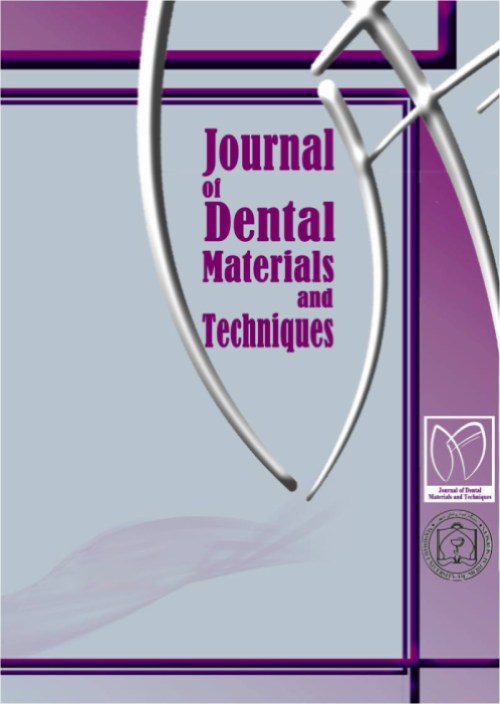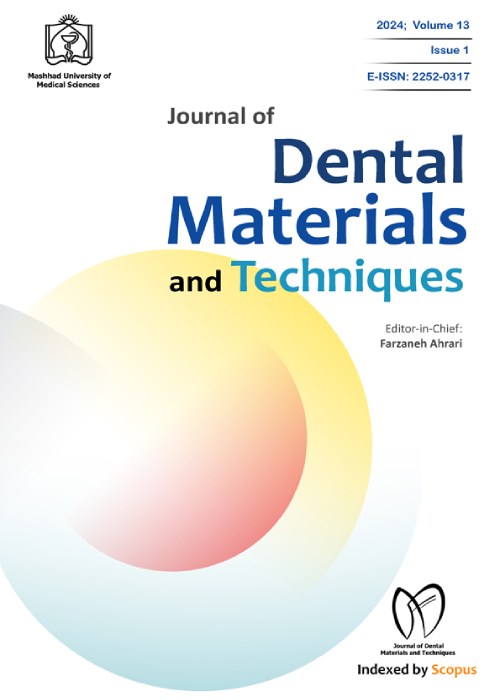فهرست مطالب

Journal of Dental Materials and Techniques
Volume:11 Issue: 4, Autumn 2022
- تاریخ انتشار: 1401/10/13
- تعداد عناوین: 8
-
-
Pages 201-204IntroductionFixed retainers are the most commonly used method of retention after orthodontic treatment. Accurate and passive adaptation of the fixed retainer wire to the anterior teeth, in addition to moisture control during the bonding procedure, are of utmost importance. Therefore, indirect bonding techniques of fixed retainers have been recently introduced to overcome the disadvantages of direct bonding methods, such as moisture contamination and changes in the wire position during intraoral bonding. Another benefit of indirect bonding methods is less dedicated chair time for bonding fixed retainers. A modified technique is used for the construction of the silicone tray in this technical note of indirect bonding of lingual retainers.Keywords: Fixed Retainer, Orthodontics, Relapse
-
Pages 205-212IntroductionDespite improvements in dentin bonding, the bond will be demolished over time and decreased by water and matrix metalloproteinase (MMP). This study aimed to evaluate the effects of the combination of different methods of MMP inhibition and detect the possible synergic effect on strength and bond durability.MethodsThirty human third molar teeth without any cracks or decay were used in this study. The occlusal surface of teeth were removed, and dentine surfaces were flattened with silicon carbide plates. After preparing for restoration, teeth were divided into 4 groups, including 1- the control group, 2- the chlorhexidine (CHX) 2% group, 3- the green tea (GT) extract 15%+rinse+CHX 2% in 30 sec, and 4- GT extract15%+rinse+CHX 2% in 60 sec for the application time of GT. Composite samples were divided into two groups, and microtensile bond strength was evaluated immediately and 3 months after storage in water. The fracture type of samples was then evaluated using a stereomicroscope.ResultsThe immediate bond strength had no significant difference in experimental groups. The mean bond strength for GT+CHX in 30 and 60 sec after a 3-month storage had a significant difference with the 3-month storage control group, however, not significant with the immediate control group.ConclusionThe use of GT extract with CHX led to bond durability after a 3-month storage. Further studies are required for investing the in vivo effect of this combination.Keywords: Chlorhexidine, grape seed extract, Green Tea Extract, Matrix metalloproteinase, Microtensile bond strength
-
Pages 213-219IntroductionDenture cleansers effectively reduce plaque formation; nonetheless, there is a dearth of studies on their efficiency in stain removal and the reduction of multispecies biofilms. The present study aimed to determine the ability of different denture cleansers to remove different stains.MethodsA total of 90 central incisors with A1 color were randomly assigned to three groups. Specimens were immersed into three staining solutions (black tea, coffee, and wine). After staining, colorimetry measurements were made, and specimens were immersed in denture cleansers (Protefix Active Cleanser and Aktident Cleansing Tablet) or tap water (control). Color difference (ΔE*ab) was determined after two, four, and six months (n=10). Data were statistically analyzed using the Kruskal-Wallis analysis and Dunn's multiple comparison test at the %95 confidence level.ResultsThere was no significant difference between the stain removal efficacy of denture cleansers and the control group for all staining solutions. When the ΔE*ab values were compared according to different time periods, specimens exposed to three different staining solutions and cleaned by denture cleaners and tap water showed no significant difference (P>0.05). In all time periods, teeth exposed to tea and immersed in the Protefix demonstrated higher color difference values (ΔE*ab>5.5). Color differences of all groups were perceptible to the eye (ΔE*ab>1.8). There were no significant differences among denture cleansers in different time periods (P>0.05).ConclusionThere was no significant difference among the denture cleansers regarding stain removal capacity. The soaking time of stained artificial teeth in denture cleansers did not change their color.Keywords: Coloring Agents, color, dentures, Denture cleansers
-
Pages 220-227The presence of peri-implant inflammation can lead to the loss of implant if extended to the bone. Therefore, it is essential to develop effective strategies for the prevention and treatment of diseases around the implant. The present study aimed to assess the effect of topical antibiotics on the prevention of implant crestal bone resorption using fractal analysis.MethodsA total of 30 patients with a mean age of 41.4 ±4.2 years and in need of dental implants were randomly assigned to three groups (n=10). The first and second test groups received 0.5% erythromycin ointment and 0.3% gentamicin, while the control group received no antibiotics. To evaluate the degree of crestal bone resorption around dental implants at baseline and three months later, a phosphor plate radiograph was taken and fractal analysis was then performed to determine the degree of resorption.ResultsThe comparison with the fractal changes between the two time intervals demonstrated that there were no significant differences in all three groups (P>0.05). There was a significant difference among the three groups in the fractal dimension (FD) index just after the implant placement (P=0.03). The control group was significantly different from the erythromycin and gentamicin groups in terms of FD index immediately after implant placement. Nonetheless, there was no significant difference between the erythromycin and gentamicin groups (P=0.07). There was no significant difference in FD among the three groups three months after implant placement.ConclusionUsing topical antibiotics did not affect bone resorption after three months of implant placement.Keywords: crestal bone loss, dental implant, Erythromycin, Fractal Analysis, Gentamicin, Topical Antibiotic
-
Pages 228-239IntroductionThe aim of the study was to evaluate the effect of disinfection and storage solutions, and time periods on the fracture strength of whole teeth and tooth sections.MethodOne hundred and sixty extracted teeth were divided into 16 groups based on disinfection methods, storage times and tooth types. Teeth samples were measured, and areas calculated. Specimens groups were 1. 10% buffered formalin, 2. 0.2% thymol-in-saline, 3. 5.25% sodium hypochlorite (NaOCl), 4. OHCWA disinfection protocol, 5. Distilled-water. Each group had storage subgroups of 14, 90 and 180 days. Group 6 (control) were frozen in distilled water for 14 days. Specimens were tested using an Instron Universal tester and load at fracture was analyzed for statistical significance.ResultsThe NaOCl group showed significantly lower loads at fracture compared to all other storage solutions at corresponding storage times. Distilled-water storage for 90 and 180 days had significantly lower fracture loads, except specimens stored in NaOCl for 14 and 90 days. The area of the specimen, was significantly associated with the magnitude of load at fracture.ConclusionsNaOCl storage significantly affected the fracture strength of teeth. Fracture resistance of teeth was inversely proportional to the storage time and directly proportional to the area of the specimen.Keywords: disinfection, storage media, Demineralization, fracture strength, Biomaterials, Materials Science
-
Pages 240-248IntroductionThis study aimed to assess the optimal concentration of propolis with and without vitamin C as a storage medium for avulsed teethMethodsFollowing the preparation of L929 murine fibroblasts suspension, 5,000 cells were seeded to each well of a 96-well plate. After 24 h, the culture medium was replaced with 0.01, 0.005, 0.001, 0.0005, 0.0001, and 0.00005 concentrations of propolis(P) and propolis plus vitamin C(PC) using Dulbecco’s Modified Eagle Medium. After 2, 24, and 72 h of incubation, the percentage of cell viability was determined by methyl thiazolyl tetrazolium assay, compared to the negative control group. Data were analyzed using the SPSS software (version 21). Two-way ANOVA was used to compare the means, while Tukey’s test was applied for pairwise comparisons.ResultsAfter 2 h, only the difference between the 0.001 concentration of P and PC was significant (P<0.005), such that cell viability was higher in the latter group. After 24 h, cell viability in 0.0005 and 0.00005 concentrations of P was significantly higher than that in the PC group. However, no significant difference was noted after 72 h.ConclusionCell viability was retained in all concentrations of propolis with or without vitamin C. On the other hand, with an increase in the concentration of propolis, cell viability decreased. Although PC was superior to propolis alone in cell viability; however, this effect decreased over time such that no significant difference was noted after 72 h.Keywords: Avulsion, Cytotoxicity, Fibroblasts, Propolis, Vitamin C
-
Pages 249-256IntroductionSelf-adhering flowable composite resins were recently introduced to combine the merits of both adhesive and restorative technologies in one product. This study aimed to evaluate the microleakage of a self-adhering flowable composite in comparison with a conventional flowable composite and resin-modified glass ionomer cement in class V cavities.MethodsIn this in vitro experimental study, class V cavities were prepared in the buccal and lingual surfaces of 20 sound human molars (40 cavities). The cavities were randomly divided into 4 groups (n=10) and restored with Vertise Flow self-adhering flowable composite in group A, Premise conventional flowable composite in group B, etched with 37% phosphoric acid and restored with OptiBond Solo Plus + Vertise Flow in group C, and Fuji II LC glass ionomer in group D. The specimens were thermocycled for 1000 cycles (5-55°C), immersed in 0.5% basic fuchsine dye solution for 24 h, sectioned, and observed under a stereomicroscope. Data were analyzed by SPSS software using the Kruskal-Wallis, Npar, and Wilcoxon signed rank tests (alpha=0.05).ResultsThe Kruskal-Wallis test showed that the degree of microleakage was not significantly different among different groups at the enamel margin (P=161) or the dentin margin (P=467). The Wilcoxon signed rank test revealed that the difference in microleakage between the dentin and enamel margins was significant within all four groups (P<0.05).ConclusionThe microleakage of self-adhesive composite, self-adhesive composite with separate etching and bonding, flowable composite, and glass ionomer cement was the same at both dentin and enamel margins.Keywords: Dentin adhesion, Dental leakage, Enamel adhesion, Resin-composite
-
Pages 257-268IntroductionThis study presents a new design of multilayered PMMA dental composite material combining electrospun continuous composite polyvinylpyrrolidone (PVP) nanofibers filled with zirconia (ZrO2) nanoparticles and two-component self-cure PMMA dental resin. The aim is to improve the mechanical properties of dental PMMA material via the large surface area of electrospun nanofibers, the toughening effect of PVP and ZrO2 nanofillers.MethodsFirst, PVP/ZrO2 composite nanofibers with different ZrO2 contents of 5%, 10% and 20% (wt. % of PVP) were prepared by electrospinning. Then, multilayered samples containing alternating PMMA resin and electrospun composite nanofiber mats with different ZrO2 contents were manufactured by lay-up process. Samples containing single and double layers of nanofiber mats were prepared and cured in a water bath dental acrylic curing device in order to prepare composites without any void.ResultsFTIR and SEM results reveal that PVP enables good interfacial interactions and compatibility between the nanofibers and PMMA matrix. The mechanical properties are improved as an increase of the flexural strength up to 83% and 67% is observed for PMMA/PVP/ZrO2-10s and PMMA/PVP/ZrO2-20d samples, respectively. The presence of PVP nanofiber layers significantly improves the flexural toughness, especially for samples reinforced with a single layer of nanofibers where improvements up to 169% and 153% are observed for PMMA/PVP/ZrO2-5s and PMMA/PVP/ZrO2-10s composite samples respectively. The micro-hardness is also higher for composite samples compared to neat PMMA dental material.ConclusionThe overall results clearly depict a noticeable enhancement of the mechanical properties, especially the flexural toughness of PMMA dental materialKeywords: dental composite, PMMA, Electrospinning, PVP, ZrO2 composite nanofibers, flexural properties


